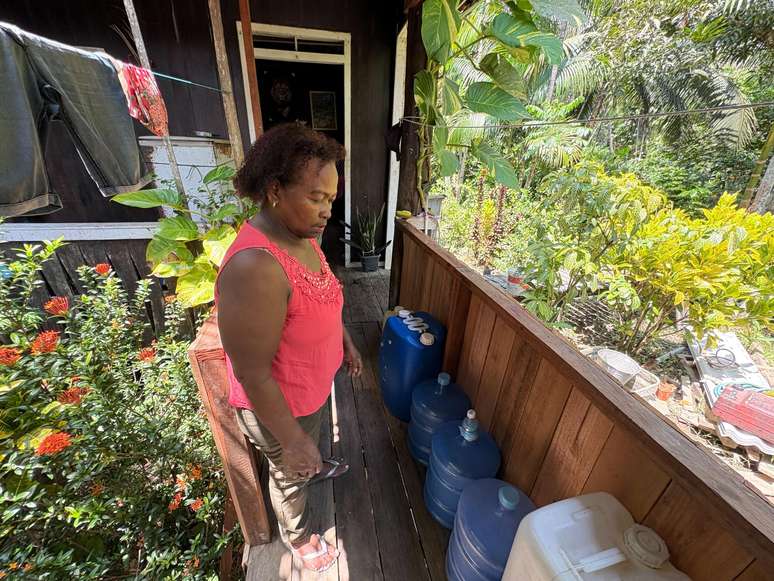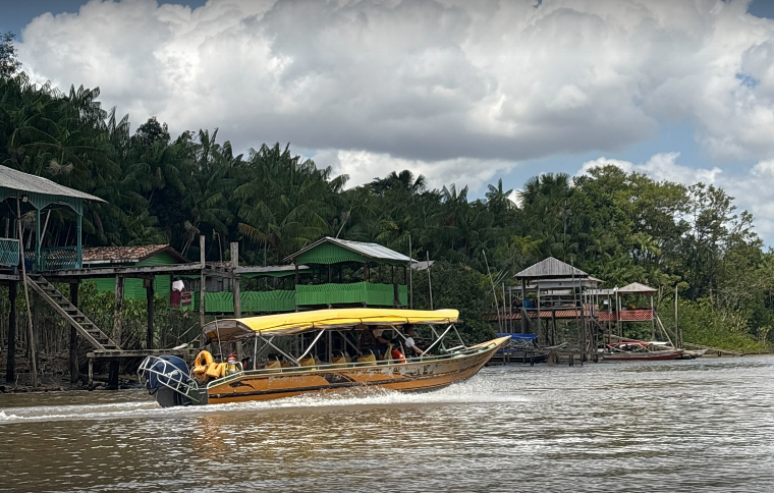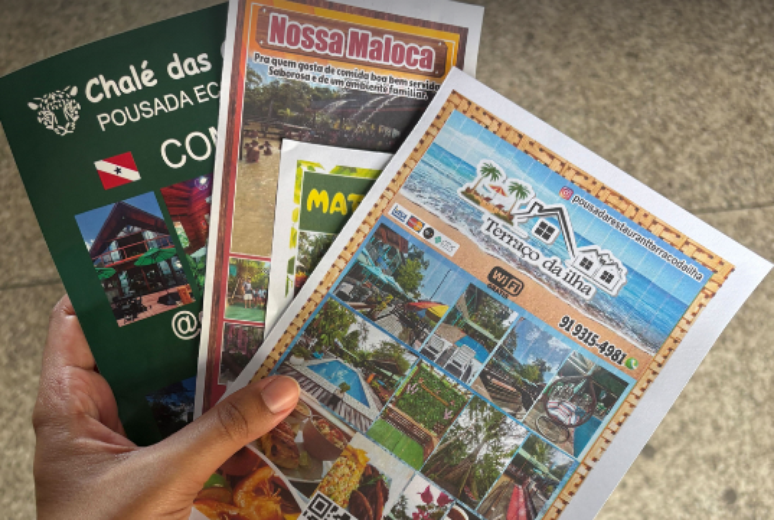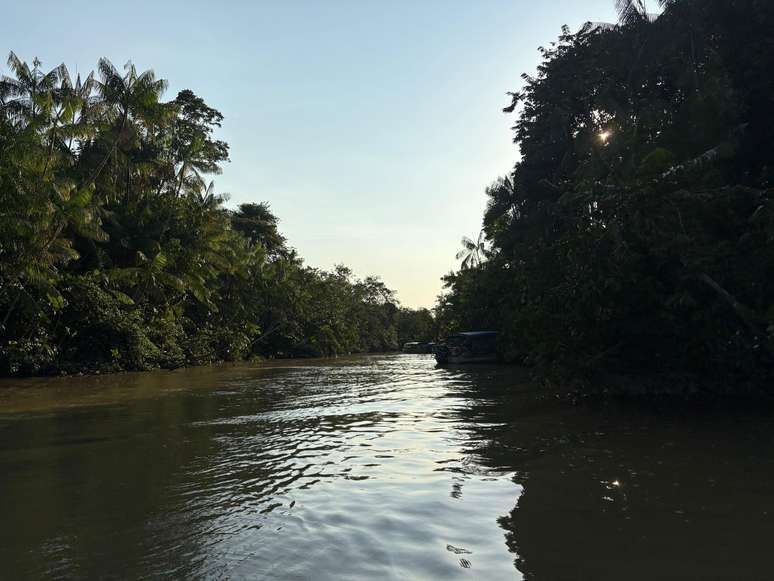
Maria Ibaneide, 64, was born and still lives on the island of Combu in Belém, the capital of Pará state, where the 30th United Nations Climate Change Conference (COP30) will be held this Monday, the 10th. When she was a child, she and her family used to fetch water from the river and drink it. Nothing was wrong, he insists. But now everything has changed and the island remains the same. Due to the increasing population of riverside communities, the intensification of predatory tourism, and the pollution of the area, it is no longer possible to consume this water.
After years of no support from city hall, residents have had to organize themselves to always have drinking water at home, either by buying it from a well 20 minutes away by boat or finding bottled water in the city, she said. Without this water, many problems will occur.
There are 5 people in your house. They typically consume about 100 liters of water per week. Once a week, she buys three 20-liter gallons of water from the well to use for cooking. For added safety, always mix water and hypochlorite. Buy at least 2 gallons of this type of expensive mineral water per week.
Values vary. Water from a well costs 4 reais for 20 liters of “botilla” (colloquially) if you take it by boat. But there is also a man who passes by Igarapé (a small waterway in the Amazon that connects communities) every week, selling containers of water. He creates a route through the houses on a particular day and the price is R$5 if you buy directly from him. The seller also sells mineral water for R12 per 20 liters. If not this route, residents will have to obtain mineral water in Belém.
The seller visits the home two days a week. However, sometimes unexpected events occur that fail to pass and do not inform us. There may be days when your family needs and relies on water to be refilled, but it’s a hassle.
“It often happens that there is no water and there is no way to get it. Then you have to find a way. Water is water, and you can die from water, right? I have already drank water from the river when I was thirsty. Not for days, not hours. But I have already filled a jug with water, heated the water, added a few drops of hypochlorous acid and drank it,” says Maria.
And all this is already part of the version.light” story. Speedboats and boats now have powerful engines that allow them to move quickly. However, in the past they were either rowboats or “po-po-po” boats (vessels with a simple engine pulling a small rope, making a sound similar to how their nickname is pronounced). At that time, the 20 minute journey took 1 hour and 30 minutes.
What about water for other domestic uses? Maria’s house, like most residents of the island, has an aquarium that draws water directly from the river. This is water used for tasks such as washing dishes, doing laundry, and using the toilet. However, in the Pirikitacuara River, as in other rivers, the water is brownish. And to make the water clearer, residents can expect to carry out home treatments with hypochlorite and aluminum sulfate, another compound used to purify water by removing impurities from it. Everything that has to do with water takes a lot of work there.
lack of support
It feels like the local community is being forgotten by City Hall. “We have no support. They never brought us gallons of water…We bought everything. We never had someone donate a gallon to us,” Maria says.
What has been more effective in changing the realities of local communities, even if slowly, are social projects by organizations and companies that propose improvements to the population, such as infrastructure improvements and even training in various fields.
One of these projects raised high expectations not only for Maria but also for other local residents interviewed in the report. This is a project that could ultimately improve the relationship between some riverside residents and their water consumption.
In this case, this is being done as part of the Regulariza program of the State Government of Pará, working in collaboration with the City of Belém, the company and the Pará State Institute for Forestry Development and Biodiversity (Ideflor-Bio). According to the government, 10 reservoirs have been installed as rainwater collection systems on the island, some of which are located in public areas such as schools.
The initial forecast was for all deliveries to be made by the second half of October. The one closest to Maria is under construction behind the Kombu Mining Women’s Association (AME), near her home, and has not yet been handed over, at least until this Sunday the 9th.
Efforts at AME have recently been intensified amid the COP30 movement, and it is hoped that the project will be realized during the event, as residents closely following the initiative said.
A life surrounded by tourism on Kombu Island
Kelp Island was electrified in 2011. Previously, there were no refrigerators and heating boxes had to be filled with ice every week to store food and have cold water to drink in the Belém heat. Anyone with a freezer had to pay the high cost of a generator. Generators were only running during the early morning hours. Lighting in houses made of wood was based on lamps. These are just two examples, but when you look back at the day-to-day impact, you can see how different everything could have been.
There was a massive struggle to gain access to the power grid. Residents said they had to attend long meetings with authorities and companies, sometimes lasting an entire day, and sometimes did not eat during the day to avoid leaving their posts. They claimed so, but they didn’t believe that one day they would actually press the button and see the light. Until everything goes well and the party turns out great. Now they say that if for some reason the electricity goes out for just a few minutes, the pain sets in and they don’t even remember how they lived without light for years.
But the party wasn’t just about joy. The measure was of great importance for the development and well-being of Kombu Island’s riverside communities, but was also a milestone in the transformation of the local tourism industry, residents’ reports said.
Since Kombu Island is declared an Environmentally Protected Area (APA) and an Amazonian “paradise” near Belém, there are several traditional restaurants that have been welcoming tourists for many years. But so many things spiraled out of control that I could count on one finger. Even without potable water, tourist demand led to the creation of dozens of restaurants along the island’s coast. Residents who have lived there all their lives say they no longer have any idea how many projects there are on average.
To get to the island of Combes, you need to take a speedboat from the Rui Balata Channel Terminal in Belém’s Princesa Isabel Square. The round-trip fare is R$24 and can be paid by cash, debit or pix. On Sunday the 9th, before COP30, the intersection was crowded with Brazilians and foreigners, and at the entrance there were several people handing out advertising pamphlets recommending restaurants to tourists.
With so many options, restaurants want to attract customers from the beginning. And when that person gets on the boat, they have to say which point they want to go to, and the boat will drop them off there. Despite literally being on the river, venue proposals to attract guests are becoming increasingly outlandish, from shows to resort-style buildings with pools.
Most restaurants have their own pier, with boats arriving every hour. And, as residents said, the flow is high not only during the COP period, but every weekend.
According to residents along the river, the desire for a share of the population has led people to clear forest land and build irregular projects across the island. Furthermore, not all establishments are concerned about the waste and environmental impact caused by intense tourism.
Previously, in addition to the benefits of acai and cocoa, residents along the rivers of Kelp Island ate the fish and shrimp they caught themselves, but this is becoming more difficult every year. The number of animals appearing is decreasing. Last year, for example, residents said shrimp “disappeared” from the river. They don’t know whether it’s because of pollution, whether the fish are suffering from rough seas caused by the heavy currents of boats and jet skis, or whether it’s because of the climate crisis itself. Or even a combination of factors. What they do know is that they are feeling the effects.
Security is also not what it used to be. Residents have reported an increase in thefts in the area, including entire speedboats with engines that cost the price of popular cars. This insecurity has restricted the free movement of residents along the river, forcing them to consider some actions that were previously completely free.
The earth contacted the state governments of Belém and Pará, requesting information about the number of establishments operating among riverside houses on the island of Combes and about cases of deforestation, environmental violations, and other crimes related to the expansion of tourism in the region. The report also questioned the local water situation and delays in the delivery of water tanks. The space will remain open and will be updated if it comes back.
In October, Belém City Hall launched a cycle of inspection and guidance for restaurants on the island of Kelm, which focuses on combating the irregular dumping of waste and sewage into rivers. The idea is to conduct monthly tests to protect the island’s water resources and biodiversity.
“Inspection teams found irregularities in the first three restaurants visited, including a lack of proper water and wastewater treatment due to lack of proper septic tanks, and even disposing of chlorinated pool water directly into the river,” City Hall said in a memo issued in October, saying it had summoned each establishment for explanations.
*Reporter Beatriz Araujo visited Belém with support from ClimaInfo.


-1hux6w92lzlte.jpg)







